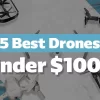Best DJI Drones: The Quadcopter Market Leaders
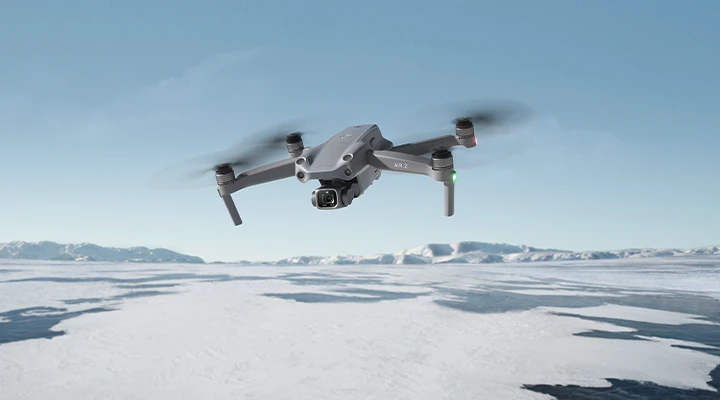
Are you turning the internet upside down to find the best DJI drone?
Whether you’re a novice pilot or a seasoned flyer, this list will help you better understand the range of options DJI has. DJI is a proven ace among drone makers and has been making flying machines for every kind of consumer’s needs over the years.
You may be interested in different DJI models depending on your goal with quadcopters. For example, if you’re an aspiring aerial photographer, the DJI Mavic Air 2 might be your ticket to the sky. With DJI‘s steady succession of affordable yet advanced quadcopters, nobody has done more to put drones in the hands of amateurs than this company.
But if you’re looking for the best DJI drone for your need, which is the best option?
Every model in DJI’s flying lineup promises easy controls and preset flying modes that make aerobatics a piece of cake and mind-blowing footage a walk in the park, even for complete beginners.
To get rid of the huge headache that comes with choices like this and to save you countless hours of research on the internet, we’ve compiled a list of the best DJI drone based on budget, camera, and safety features. So buckle down and keep reading to know which DJI fits you best.
One thing to note before reading the list is that there’s an evolving body of regulations surrounding drone flight and appropriate usage that you should get familiar with before buying these quadcopters.
The Best DJI Drones
DJI Mavic 3 (Best Drone Overall)
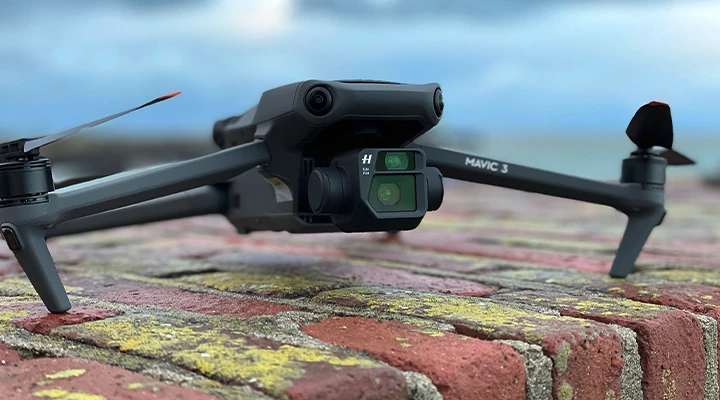
The DJI Mavic 3 is a worthwhile upgrade if you’re willing to pay considerably more for a better camera and improved obstacle-avoiding systems.
Specifications
| Camera resolution | 12MP/5.1K50 |
| Battery | 46 minutes with a full charge |
| Weight | 895g |
| Dimensions | 22,1×9,6x9cm (folded) |
| Price | $2000 |
The DJI Mavic 3 is a worthwhile upgrade if you’re willing to pay considerably more for a better camera and improved obstacle-avoiding systems.
With its 4/3 sensor, the Mavic 3 takes crisp, clear photos and videos, and its Hasselblad-branded camera makes the footage extremely colorful. The Mavic 3 can also sense obstacles coming from most directions and adjust to avoid them effectively, making this Quadcopter suitable for newcomers.
In flight, the Mavic 3 uses sensors to detect obstacles up to 200m away approaching from its sides. The quadcopters have obstacle-avoiding sensors on the front, back, bottom, and top. It can also adjust its flight path in real-time to avoid collisions. This is incredibly useful if, let’s say, you’re flying to a tree, the Mavic will warn you and avoid the obstacle on its own with a loud beep. One thing to note is that the side sensors on the Mavic 3 work only while you’re in Tripod, POI, QuickShot, and ActiveTrack mode. If you need to fly close to an object to take shots, you can turn off the obstacle-sensing systems.
Mavic 3’s camera is nothing short of incredible, with a 20MP and 5.1K camera branded Hasselblad (a Swedish company known for their high-quality cameras.) This camera has a 4/3 CMOS sensor that can work in lower-light conditions easily to give you amazing shots. DJI also claims they adapted Hasselblad’s method for making colors look more realistic without fine-tuning color settings. The colors look more vivid on the Mavic 3 compared to the Air 2. The Mavic 3 also shoots 5.1K video up to 50FPS per second with a 200Mbps max bit rate. You can also set the aperture of the lens between f/2.8 and f/11.
Surprisingly, the Mavic 3 has a second camera located above the Hasselblad lens. This camera is meant to be used for telephoto photography and has a ½-inch sensor that can shoot 12MP images and 4K videos with a 4X digital zoom.
The Mavic 3 is one of the most stable drones DJI has. It hovers accurately and resists wind drifting with ease. Thanks to the APAS 5.0 (a safety system that the latest DJI drones have), you’ll have more than enough trust in your Mavic 3 to focus on taking the most breathtaking shots instead of worrying about crashing.
Battery life is arguably one of the best for consumer drones. It goes up to 46 minutes with a full charge. DJI says you can fly the Mavic 3 up to 30km away, but you need to have a spotter to legally fly it this far away from you.
The Quadcopter folds down and is slightly larger than the Mavic Air 2 but is just as portable.
All things considered, the Mavic 3 is arguably the best DJI drone on the market. With its two cameras, advanced obstacle avoidance, and incredible battery life, this Quadcopter is hard to beat. The only downside to this flying machine is the price, at $2000, this drone isn’t made for all pockets.
The DJI Mavic 3 is a leap forward for folding drones, thanks to its fantastic video and photo footage. In many ways, it’s everything drone fans could hope for, with an excellent 4/3 camera, adjustable aperture, and high range, all packed into a bundle lighter than its predecessors.
Pros
- Mind-boggling 4/3 camera
- Adjustable aperture
- Incredible safety features
- Handy second camera
- Great battery
Cons
- Expensive
- Basic controller lacks info screen
- Quite heavy
DJI Air 2S (Best Camera Drone Under $1000)
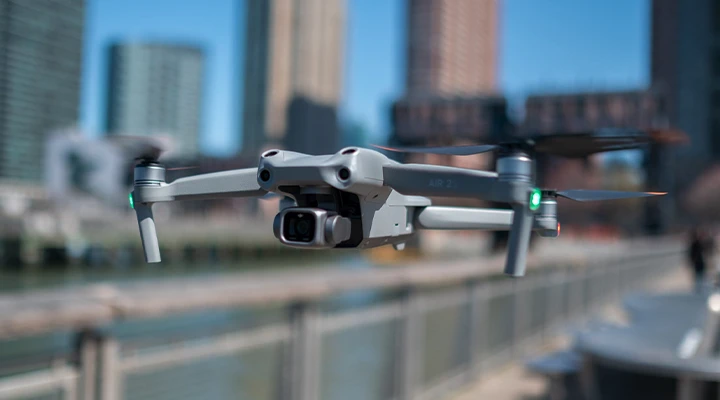
This Quadcopter is another close contender for the best DJI drone on the market. The Mavic 3 is still our best pick overall, but it’s also expensive when compared to other DJI drones that can be almost as good but with an accessible price point.
While the name of the Quadcopter suggests that it’s only a mere upgrade of the older Mavic Air 2, there are a lot of staggering upgrades in this drone, most importantly, a 1-inch sensor that lets you take breathtaking footage.
Image quality is superb, as you would expect from a camera lens of this caliber and the noise levels at high ISO settings are much better than Air 2S’s predecessors. Yet, images are slightly softer at the edges, and the aperture is fixed at f/2.8, so the only way to control exposure during video recording is by using filters.
The Air 2S sports a 20MP 1-inch sensor, which improves image quality and provides an improved high ISO response compared to the Air 2. For videos, it can shoot 5.4K video at 30 FPS, 4K videos at up to 60fps, and 1080p at up to 120 FPS, which opens up the significant creative potential for capturing video.
Another feature hyped up is the Air 2S’s digital zoom, which starts at 4X with 4K30FPS video and goes up to 8X zoom with 1080p. This feature may not sound as exciting as the rest, but maintaining a safe distance can be crucial if you factor in how many restrictions there are that don’t allow you to get too close to certain objects or people. This can be an essential feature, especially for professional drone pilots, and for enthusiasts, it will open the doors to more staggering footage of their trips.
Still, we think the DJI Air 2S is one of the best drones overall for most people, especially if the camera is your focus. This Quadcopter is hard to beat thanks to its combination of a large 1-inch sensor and compact, travel-friendly dimensions.
Read our in-depth DJI Air 2S review
Pros
- One of the best cameras in this price range
- Small and lightweight
- Easy to use and fly
Cons
- No adjustable aperture
- Weighs over 250g
- Image edges are slightly softer
DJI Mini 3 Pro (Best DJI Drone Under $1000)
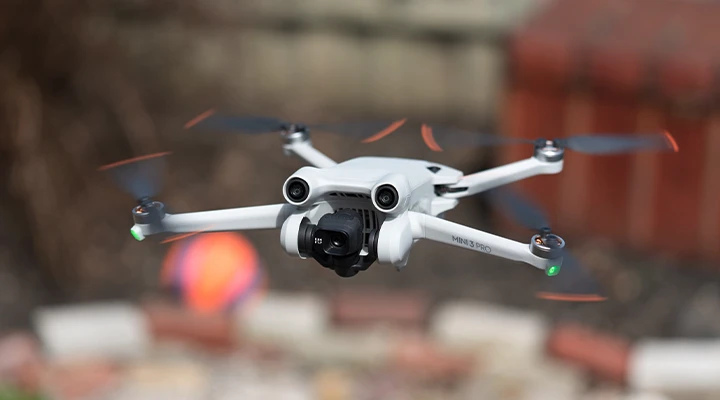
The tiny and lightweight DJI Mini 3 Pro takes DJI’s popular mini drone series to new heights. The new Mini 3 brings the ‘wow’ factor to the sub-250g category.
Specifications
| Camera resolution | 12MP/4K60 |
| Battery | 34 minutes with a full charge |
| Weight | 249g |
| Dimensions | 14,5x9x6,2cm (folded) |
| Price | $829 |
The tiny and lightweight DJI Mini 3 Pro takes DJI’s popular mini drone series to new heights. The new Mini 3 brings the ‘wow’ factor to the sub-250g category.
One of the critical aspects of the Mini 3 is that while being so powerful in the specs department, it still weighs 250g, which means it doesn’t need to be registered in most countries. These features, along with the new DJI RC Smart controller that’s available in the priciest option of the Mini 3, make this drone a tempting option for aerial content creators.
What’s most impressive about this newcomer drone is that DJI has included a tri-dimensional obstacle avoidance system inside such a small drone, and that’s not even the most mind-boggling improvement over its predecessors. The Mini 3’s sensor is bigger and is now a 1/1.3-inch CMOS chip. Its lens’s maximum aperture has been improved to a bright f/1.7, and its video capabilities have been vastly increased too. The video camera boasts a 4K resolution at up to 60FPS, 2,7K60FPS, and 1080p up to 120FPS. The camera can also be rotated 90 degrees, enabling you to capture stills and video in both landscape and portrait format.
The list of improvements doesn’t stop here, though, as there’s much more to the Mini 3 Pro.
The only downside to the Mini 3 Pro is the increased price relative to its predecessor. However, this price leap is to be expected if you factor in all the specs and key features this Quadcopter provides.
The DJI Mini 3 Pro is a serious upgrade for the Mini series and the best compact drone you can buy right now. With its large sensor, built-in obstacle avoidance, and intelligent flight modes, it packs the performance of larger and more expensive drones into a compact and convenient package. Even though the Mini 3 Pro is catered towards beginners, its price tag lifts it to a more seasoned and exclusive audience.
Read our in-depth DJI Mini 3 Pro review
Pros
- Staggering camera performance
- Useful obstacle avoidance system
- Easy to fly
- Weighs less than 250g
Cons
- A bit expensive
DJI Mini 2
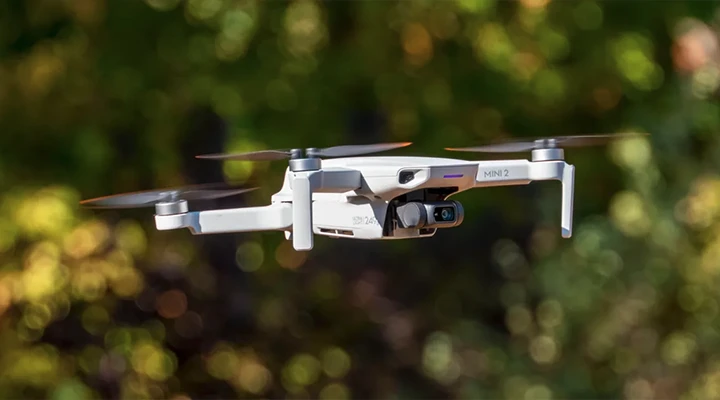
The Mini 2 hardly stands a chance if we compare it to the previous two drones. However, the DJI Mini 2 is almost unbeatable from a price standpoint.
| Camera resolution | 12MP/4K30 |
| Battery | 31 minutes with a full charge |
| Weight | 249g |
| Dimensions | 13,1×8,1×5,8cm (folded) |
| Price | $459 |
It’s an ultra-compact drone that’s so small and easy to use that you can slip it out of a backpack and launch it within seconds. It’s been succeeded by the Mini 3 Pro but remains one of the best affordable alternatives on the market today. The price tag of the Mini 2 also makes it the best beginner drone for those who want to have a great camera at a budget price.
Mini 2’s design is basically identical to that of the Mavic Mini, but the controller has been revamped, which is now sturdier and delivers a boosted flying experience compared to its predecessor. The Mini 2 is foldable with arms that fold in to transform into a truly palm-sized machine.
The Mini 2’s video capabilities are incredible, and the video is rock-steady even in the windiest conditions, which is impressive for such a small drone. Even with level 5 winds, taking stable and crisp-clear videos was child’s play for this machine.
Unedited footage can look flat and overexposed, but it’s clear that DJI processes footage cautiously and with video editors in mind. Digital zooming is limited to 2X if you’re shooting in 4K, but you can get to 3X for 1080p footage. Mini 2’s camera performance in low light isn’t that good, though, and as soon as the light drops, so does the usable zoom range.
One good thing about this drone is that it weighs 249g, so it doesn’t require a registration to be used, but the lightweight is maybe the least impressive feature of this machine. The DJI Fly app is also a well-balanced combination of simple-to-use but handy features for both pros and newcomers. Casual drone flyers won’t need to venture too much into these modes, but there’s plenty to master if you want to.
DJI is known for its stabilization features, and the Mini 2 delivers a fantastic, exceptionally stable flight experience.
Lastly, the battery is solid, with around 30 minutes of flight time on a single battery charge while shooting mixed 1080p and 4K resolution videos.
The DJI Mini 2 is the perfect entry-level drone for beginners looking for a fantastic camera to capture beautiful landscapes and cityscapes. It offers a staggering 4K resolution camera despite its small sensor size, however, it lacks an obstacle avoidance sensor, which can be an issue for newcomers.
Pros
- Easy to fly
- Compact and light drone
- Great battery
- Cheap
Cons
- Camera isn’t great in low-light conditions
- No follow-me mode
DJI Avata (Best DJI FPV Drone)
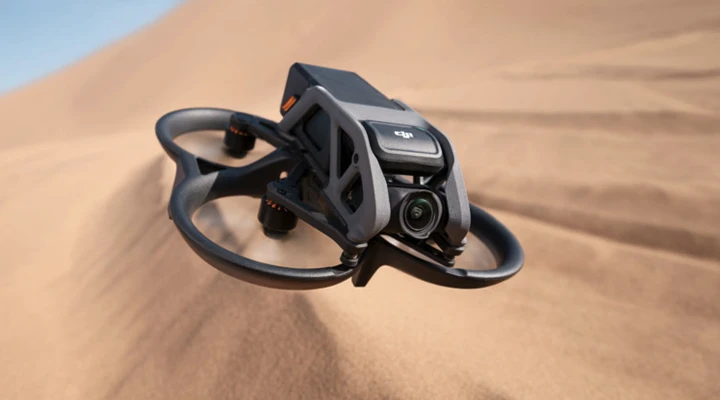
FPV is an incredible experience, as you’ll feel like you’re a bird flying through the clouds. However, the critical issue is that this type of flying is a significant departure from flying camera drones, and not all pilots will enjoy it. Motion sickness is a real possibility for some pilots flying the Avata, and flying a drone from a first-person perspective is a lot different from a third-person view you may be used to.
Specifications
| Camera resolution | 48MP |
| Range | 10km |
| Weight | 410g |
| Controller | Included |
| Price | $1100 |
| Battery | 30 minutes with a full charge |
| Measurements | 18x18x8cm |
This change in perspective makes it much harder to calculate distances, and if you fly the Avata in tight spaces with multiple objects, you’ll likely crash a couple of times. Although the Avata lacks collision sensors, DJI’s Quadcopter has plenty of safety features to make it as sturdy as possible.
The Avata has propeller protection to ensure your drone can survive multiple crashes without too many issues, and many pilots can attest to that.
Another issue with the Avata is its weight, at 410g, you’ll need to register the drone before flying. And on top of that, the price is also extremely high ($1000+ for the combo with the goggles) compared to the competition on this list.
You can fly the Quadcopter indoors or outdoors while shooting impressive 4K60FPS videos and staggering pictures, but we advise you to always check for other people before flying the Avata. Because of the fact that it’s pretty tricky to calculate distances with this drone, you can easily crash into someone causing some severe damage if you’re not careful enough.
So we recommend the DJI Avata only to those with a bigger budget who want a unique first-person view mode experience.
Read our in-depth DJI Avata Pro review
Pros
- Crash resistant design
- FPV view is amazing
- Large sensor for mind-blowing footage
Cons
- Expensive
- No collision sensors
- Hard to manoeuvre
Final Words
DJI drones are some of the best ways to conquer the skies, even if they do sometimes run on the pricier side. However, DJI has constantly put out some of the market’s best quadcopters.
Whether you’re a professional looking to get incredible footage for your business, or an amateur pilot who wants to experience the feeling of taking pictures and videos from a perspective that would normally be impossible, DJI probably has the perfect drone for you.

